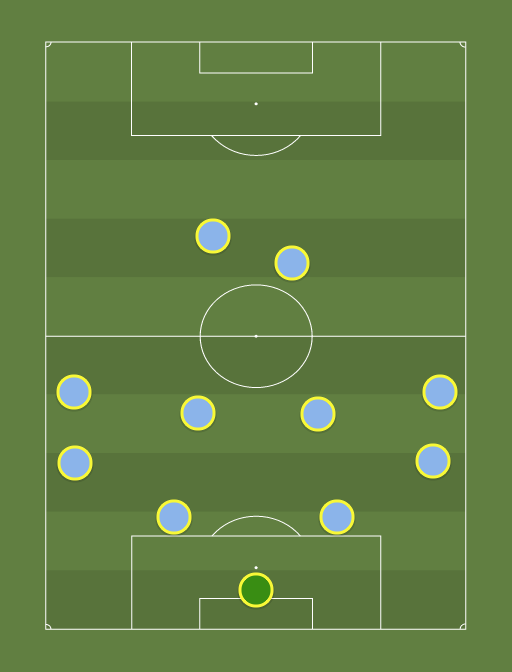 |
| Manuel Pellegrini will have his task cut out next season |
Manchester City made a strong finish to their trophy-less 2014/15 season, winning their final six games in the Barclays Premier League and comfortably finishing in 2nd place, ahead of Arsenal and Manchester United, who looked likely to finish above them at one stage during the campaign.
Manuel Pellegrini deployed his side in the 4-2-3-1 system for the final seven league fixtures, including the 2-4 derby defeat at Old Trafford, and the results were there to be seen.
It wasn't a major innovation from 'the Engineer', who, during his reign at the Etihad Stadium, has been continually castigated for his inclination to playing the 4-4-2 formation, one which saw the 2013/14 English champions score a whopping 156 goals across all competitions.
Pellegrini's decision was also forced, in many ways, due to Edin Dzeko's poor form and disillusioned exterior; Wilfried Bony, the new recruit from Swansea City, suffered ankle and knee injuries during the latter stages of the campaign, making the manager's decision all the more straightforward.
Looking ahead to next season, what sort of a system can Pellegrini deploy his side in? The Chilean is a firm believer in his methods, though some would argue that his dogmatism is uncalled for, with City vying for domestic and continental honors.
When the Etihad outfit brought in the likes of Eliaquim Mangala, Fernando Reges, Frank Lampard and Bacary Sagna, who were the outfield players to sign for the then defending champions, last summer, their system didn't need tweaking.
The addition of the aforementioned quartet to the City squad meant that their midfield and rearguard were not only strengthened, but could also be rotated - which is exactly what Pellegrini did for a majority of their campaign.
This summer, the club seems motivated to sign a world class player, with Paul Pogba and Kevin de Bruyne topping the coveted list of players.
The question, therefore, is whether the new additions will force Pellegrini to tinker with his playing system? And, if so, what formation could the Sky Blues line-up in next season, in the UEFA Champions League and domestic competitions?
Read on...
A lot has been said about the way City have lined-up over the last two seasons, with particular emphasis placed on getting outnumbered in midfield whenever Pellegrini's side has played in the 4-4-2 formation.
However, not many have been aware of the notion that it is the players who make the system work, and not the other way around.
Let us take the 4-2-3-1, or 4-4-1-1, formation for instance: usually, David Silva plays as the No.10 and Sergio Aguero, the club's No.1 striker, plays up top. Now, when City are out of possession, Silva remains high up the pitch along with Aguero, and their team drops into two banks of four.
 |
| Average positions of City players in a 4-4-2, when out of possession |
Therefore, 4-2-3-1 or 4-4-1-1 is hardly any different from a 4-4-2 formation, especially without possession of the ball.
When in possession, it is fundamental that City work as a team and do everything possible to find the back of the net, leaving the two central defenders along with Fernandinho, the No.4 or midfield pivot, to do the bulk of the defensive work when a turnover in possession occurs.
Talking of next season, Pellegrini might have to play a different formation if either Pogba or de Bruyne joins up with the existent City squad.
The Cityzens already have three midfielders - Toure, Fernandinho and Fernando - at their disposal, and only two of them can play in the 4-2-3-1 or 4-4-2 systems.
De Bruyne, though, is versatile and could be deployed in at least 2 or 3 positions, making it possible for City to continue lining up in the aforementioned systems, with the Belgian and Silva presumably forming a good partnership in the attacking-third with Aguero.
City lining up in the 4-3-3 system is not out of the question, if Txiki Begiristain and co. bring in the players who are reported to be interesting them.
 |
| De Bruyne will give Pellegrini many tactical options to choose from |
Such a formation will make profound changes to City's engine room, which could then have one of the two Brazilian midfielders playing as a solitary pivot behind Toure and, possibly, one amongst de Bruyne and Silva partnering the Ivorian in that advanced midfield position.
Jesus Navas and Samir Nasri, you would think, will flank Aguero in the final-third.
The 4-3-3 formation will give City a lot more potency when attacking, while also giving them better defensive solidity than what they enjoy in a 4-2-3-1 or 4-4-2.
The notion, however, remains the same: each player has to play his role well, in order to make the system work.
Final Thought
It remains to be seen what City do with Dzeko and Stevan Jovetic, and whether the duo is shown the door when the Transfer Window opens in July.
However, regardless of what happens to the aforementioned duo, or even one among them, don't be surprised if Pellegrini sticks with the 4-4-2 system in the Premier League and cup competitions.
In Europe, City could lineup in the 4-3-3 formation, that is if they bring in more central midfielders.
 |
| City, simply put, defended flimsily last season |
Finally, City's defensive struggles last season were not due to the formation they played in, but because of the defenders' - Vincent Kompany and Mangala, in particular - poor form throughout the campaign, which led to their side conceding some really cheap goals against considerably lesser opposition.

No comments:
Post a Comment